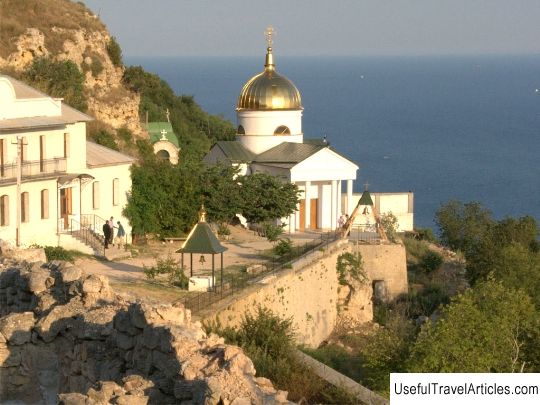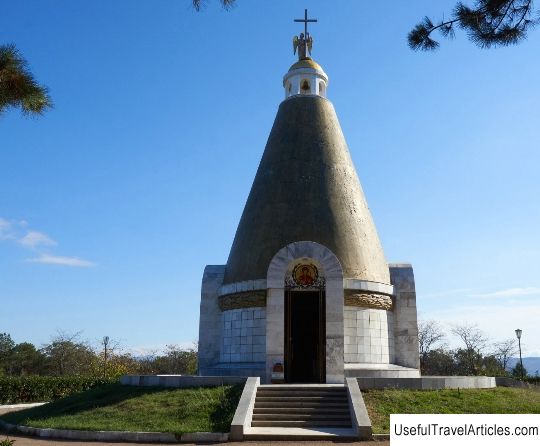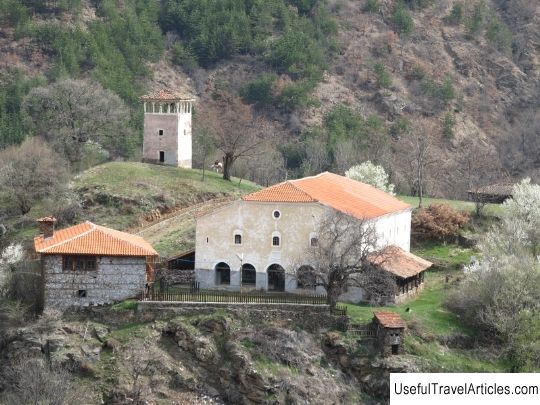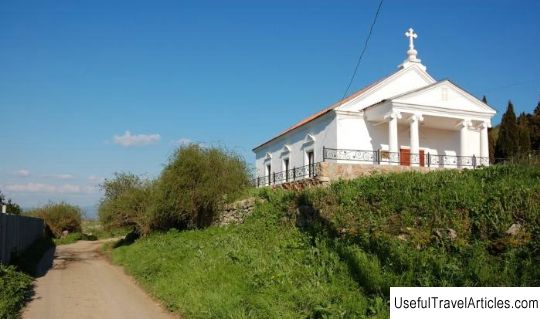St. George Monastery description and photo - Crimea: Sevastopol

St. George Monastery description and photos - Crimea: Sevastopol. Detailed information about the attraction. Description, photos and a map showing the nearest significant objects. Photo and descriptionThe St. George Monastery in Sevastopol is located on Cape Fiolent. This is a functioning monastery with preserved buildings of the 19th century. A picturesque place that still remembers A.S. Pushkin. From the Georgievskaya rock, magnificent views of the surroundings open. History of the monasteryThe monastery is located on a cliff at Cape Fiolent . Tradition traces its foundation to 891. They say that once a storm found several Greek ships here and they nearly crashed on the coastal rocks. But the sailors prayed to Saint George - and the storm miraculously subsided. On a high rock, Saint George himself appeared to them. Then they erected a cross on it, visible from everywhere, and a little lower, on the slope of a rock, they founded a monastery. Church, dedicated to their savior - Saint George - was set up in a cave, and a icon of a saint found on a rock was placed in it. Since then, the rock has been called the rock of the Holy Apparition or St. George. Once on one of the surrounding rocks there was a pagan temple of Artemis. Who visited these places in the 1820s A. S. Pushkin saw its ruins. Tradition connects the plot of the tragedy of Euripides “Iphigenia in Taurida” with these places. The legend tells how the goddess Artemis demanded that the Greek king Agamemnon sacrifice his daughter Iphigenia in exchange for help in the Trojan War. The goddess took the girl to Taurida (that is, to the Crimea) and made her a priestess in her temple on the seashore. Tradition says that the very icon that was once found on the rock has survived. True, it dates back to a later time - XI century , but perhaps this is one of the first copies of it. The date was determined during the restoration in 1965. The icon was taken from the monastery to Mariupol after the annexation of Crimea to Russia in the 18th century. In the late 19th - early 20th centuries. she was periodically brought here to "stay". Currently, the icon is in the National Art Museum of Ukraine . The first written mention of the monastery, however, dates back to a much later period. This monastery is described by the Polish diplomat and traveler Martin Bronevsky . He was in the Crimean Khanate the ambassador of the Polish king Stefan Batory , lived in Crimea for almost a year, and left a detailed book about everything he saw - "Description of Tataria". In this book, he writes, among other things, about the St. George Monastery and those who flock to Cape Fiolent on St. George to numerous crowds of Greek Christians. Since the capture of Crimea by the Ottoman Empire , the monastery begins to decay. He was robbed several times, all the jewelry from it passed into the hands of the Turks. In 1637, the monks complained to the Russian Tsar Mikhail Fedorovich about the ruin and asked for help. However, the monastery remained among the four Crimean monasteries that retained their status even during the Ottoman yoke. The monastery was subordinate to the Patriarchate of Constantinople and most of the monks in it were Greeks. After Crimea became part of Russia, they did not want to change jurisdiction and left this place, moving to Mariupol. Core values, including silver utensils, they sent to Constantinople. The monastery archive was also sent there - that is why now there is no exact documentary evidence of the foundation date of the monastery. And the monastery itself - now Russian - at the beginning of the 19th century became " naval ". It was home to the clergy, who were responsible for the Russian Black Sea fleet. There were 26 hieromonks in the monastery, but not all of them lived here permanently. They went sailing with ships. A major reconstruction belongs to this time monastery: in 1816 the old dilapidated St. George Church was demolished and a new one was built, as well as new buildings of cells and a refectory. The monastery at this time was quite famous. Everyone who, for some reason, ended up in Crimea, certainly came here. Pushkin, Griboyedov, Bunin, Chekhov - they were all here. A beautiful view of the monastery from the sea was painted by Aivazovsky . The monastery was not damaged during the Crimean War, despite the fact that it was occupied by allied troops, and in 1891 it magnificently celebrated its millennium. By this time, the main buildings of the monastery were renewed again, and a grandiose staircase to the rock was built, which is now one of the main attractions. At the same time, the remains of a cave church were found - perhaps the very first one, created in the 9th century. The cave was cleared, consecrated - and a temple in the name of the Nativity of Christ was created here. In 1898, a new temple was laid here - Voznesensky . It was made in memory of the salvation of Nikolai, still Tsarevich, from an attempt on his life in Japan in 1891. Nicholas himself and the entire royal family, who loved to relax in the Crimea, were present at the foundation of this church. After the revolution, the monastery was not closed, but its property was nationalized, and the community was transformed into a labor state farm "Georgievsky Monastery", most of whose population remained monastic. However, the abbot was arrested in 1923, like many priests in the case of confiscation of church valuables. At the same time, the marble cross, which towered over the Rock of St. George, was destroyed. St. George's Cathedral was badly damaged during the terrible earthquake in 1927 . Soon after, the temple was dismantled. The monastery itself was abolished in 1929, but even before 1930, services continued in the Ascension Church. After its final closure, a sanatorium of OSOVIAKHIM was set up here; during the Great Patriotic War, officers' courses and medical and sanitary battalions were located. After the war, a military unit was located on the territory of the former monastery - some of the buildings still belong to it. Revival of the monasteryIn 1991 , by the 1100th anniversary, the monastery was revived. For the church new year - September 14, 1991 - a cross was again installed on the rock. It is made of metal, rises seven meters and weighs 1,300 kilograms. They took him to the cliff by helicopter. The first divine service on the territory of the monastery took place in the spring of 1993. The Liturgy was served by the Archbishop of Simferopol and Crimean Lazar , representatives of the city authorities and even the head of the Black Sea Fleet were present. The monastery, as in the 19th century, performs the function of nourishing and consecrating the Black Sea fleet. For example, in 1997 St. Andrew's flags of military units were consecrated here. In 2000, the restoration of the church of St. George and it was completed only in 2009 The monastery is now One of the main attractions of the monastery is the stairs leading to the St. George's rock. It has about 800 steps and rises 640 meters in height. A cross rises on the rock itself. When visiting, you should be careful - the staircase is quite steep, and it has no railings. From above there are magnificent views of the sea and the monastery. In the monastery itself, there is an old monastery refectory built in 1838 and a bell tower from the middle of the 19th century. It has its own b> holy source - St. George. The rotunda above it was erected in 1816 and renovated in 1846 and then in 2000. This is one of the oldest buildings of the monastery. The water is considered holy and healing, it was advised to drink it by the well-known monastery elder Kalinnik, who lived to be 116 years old. Now the source is being restored - in Soviet times it was clogged and actually dried up. Also worth seeing is Nativity Church 1893. This is a stone structure above an ancient cave church. The main temple of the monastery - St. George - quite accurately recreates the historical appearance of the classicist temple, built here at the beginning of the 19th century. This is a one-domed church with colonnades. One of its main shrines is a copy of the very ancient icon of St. George , which is now in the museum. Another revered monastery icon is a list with Iverskaya . She is in the specially built Iverskaya chapel. The chapel was destroyed during the Soviet era and rebuilt in 2000 The monastery necropolis with the graves of the abbots and old chapels above them has been partially preserved. In 1983, a monument to the poet Alexander Pushkin , who visited these places in 1820, was erected on the monastery territory. The monument is a rotunda gazebo. Pushkin is remembered here - for example, in 1996 the International Crimean Pushkin Readings took place in the monastery. At the same time, a memorial service for the poet was served here. Not far from the cave temple there is a monument to St. Andrew the First-Called , patron saint of the Russian fleet. The monastery has two courtyards : the Church of Constantine and Helena in the village. Naval and the Church of the Twelve Apostles in Balaklava. As a rule, from Sevastopol you can not only get here on your own, but also take an excursion. Since the monastery is active , then there are some restrictions: you can not appear in open summer clothes, women must be in skirts and with a covered head, photography inside the temples is limited. Interesting factsIn time immemorial, Cape Fiolent was an active volcano . The modern Georgievskaya rock is a part of one of the craters overlooking the sea. Count I. Witt is buried on the territory of the monastery. Before the war of 1812, he was a double agent, working simultaneously for Napoleon and for Russian intelligence. During the war he took part in hostilities, commanding Cossack regiments. After the war he commanded military settlements on the territory of Little Russia. The Decembrist Pavel Pestel was in love with his stepdaughter - Isabella Walevskaya . At the foot of the monastery is the famous Jasper Beach , covered with beautiful variegated pebbles. Notes
    We also recommend reading Karaite Kenassa description and photo - Crimea: Evpatoria Topic: St. George Monastery description and photo - Crimea: Sevastopol. |




